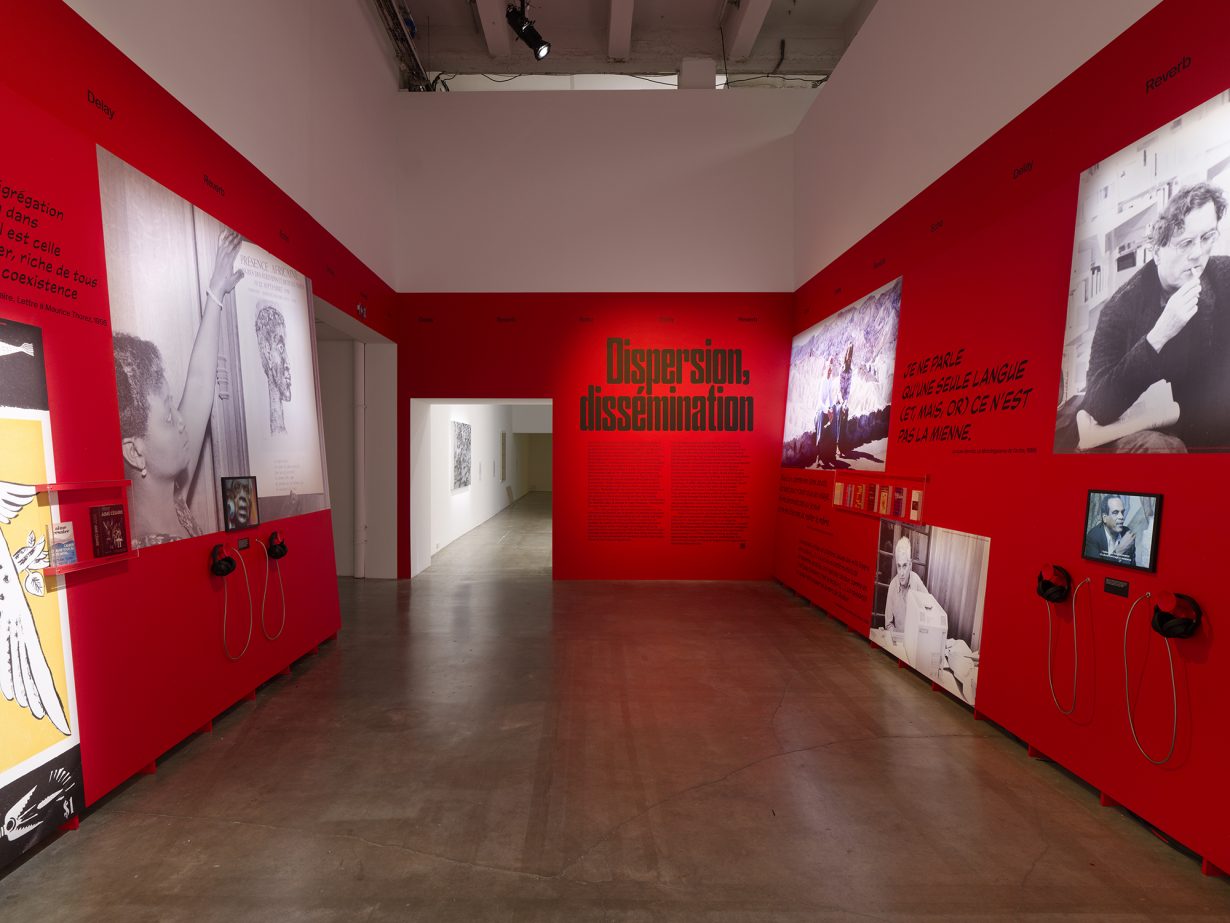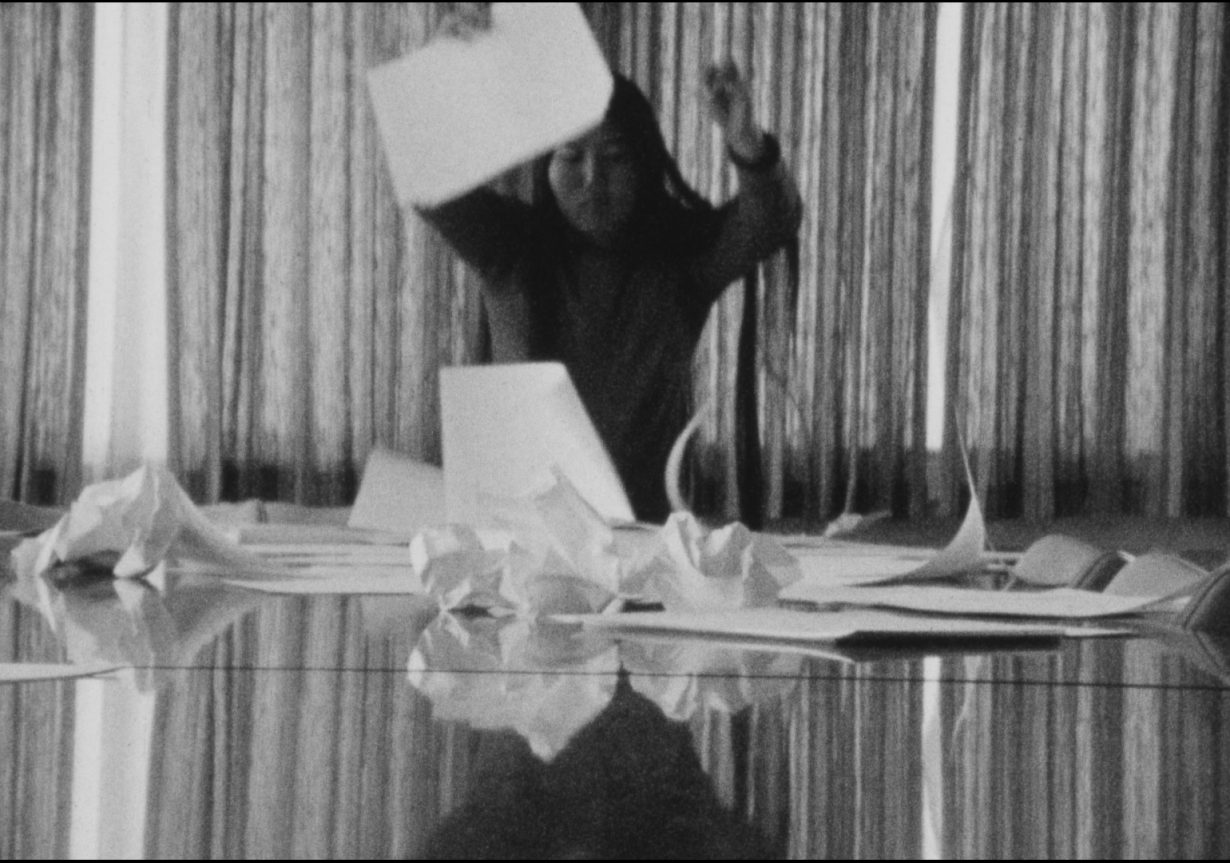What does this bookwormish exhibition have to say about the histories and afterlives of critical discourses?
Just one day after the Palais de Tokyo opened its ambitious exhibition Echo. Delay. Reverb. American Art, Francophone Thoughts, curated by Guggenheim chief curator (and artistic director for the next Documenta) Naomi Beckwith, the institution was hit by controversy: Cameron Rowland’s Replacement (2025), for which the artist swapped the French flag outside the building for the Martinican one, was removed from its mast. The green, red and black flag – created in the 1960s by anticolonial activists and officially adopted by the island (and French overseas département) only in 2023 – carries a complex history Rowland hoped to make visible to a metropolitan French audience. All that now remains of the work is a label in the corner of an exhibition room explaining that the work ‘could be considered illegal’ – beneath which an angry visitor has scrawled the word ‘honte’ (‘shame’ in French).
Why the self-censorship? The institution’s director told Le Quotidien de l’Art that the removal was to avoid any breach of the principle of neutrality – a rule repeatedly invoked by France’s recently departed home secretary, Bruno Retailleau, in a series of circulars to public institutions issued after France’s recognition of Palestine – which ‘prohibits the display on public buildings of symbols expressing political, religious or philosophical claims’. A principle that seems to concern some flags far more than others. Meanwhile, according to Le Quotidien, Rowland was advised by several lawyers that the Martinican flag, as an emblem adopted by a French territorial authority, did not violate the neutrality principle, and that the work was further protected under copyright law.

If it was a staged performance, it couldn’t have be more effective: a meta-institutional critique exposing how art institutions crave the aura of critical discourse without accepting the risks of real political stakes, and how the principle of ‘neutrality’ can be used selectively to police symbols under an increasingly right-wing government. But in reality, the staging was of a different kind: the institution accepted the work only to censor it a day later, in a manoeuvre that reads like a performance of criticality – a way to include the gesture without enduring its political effect. The result feels not just ironic, but downright cynical – not to mention a distraction from the brilliant show that awaits visitors inside.
Unfolding across the whole of the Palais de Tokyo, Echo. Reverb. Delay. is underpinned by a premise that feels both so evident and yet has rarely been articulated in an exhibition until now: that American artists (and the academia before them) have long absorbed, transformed and re-exported the ideas of French and francophone thinkers from the 1960s onwards, not only echoing but reshaping these ideas in the process. (Although one could argue Beckwith is here picking up where the 1977 Pompidou show Paris-New York, which traced similar transatlantic connections from early-twentieth century to the 1960s, left off.) Simply put, it’s a show about how the circulation of ideas can spark radical transformation.

At the heart of Beckwith’s reckoning is a deliberately expanded constellation of what makes up the so-called French theory: there’s the usual poststructuralist suspects – Michel Foucault, Jacques Derrida, Roland Barthes, Deleuze & Guattari, Julia Kristeva, Monique Wittig, etc – but also the decolonial thinkers whose work emerged from France’s former Caribbean and North African colonies – Aimé Césaire, Frantz Fanon, Édouard Glissant. The show studies how their ideas first moved through American university campuses and academia before being transformed by artists, and maps these rhizomatic connections between thinkers and artists, and across territories and sociopolitical contexts.
Each of the show’s thematic sections – ‘Dispersion, Dissemination’, ‘Institutional Critique’, ‘Geometries of the Non-human’, ‘Desiring Machines’ and ‘Abjection in America’ – opens with massive wall text filled with quotes, black-and-white portraits of authors and a vitrine display of (the first English translation of) the key texts it references. If the latter feels like a somewhat aggrandising way to the role of the academic and publishing world in circulating those ideas, it does provide a useful timeline for the viewer to measure the speed – or delay – of that circulation. There’s also an additional documentary section introducing the pivotal role of Sylvère Lotringer’s publishing project Semiotext(e), responsible for transporting so many of these ideas.
In some of the work on show, the influences of French Theory are vividly palpable, as if to demonstrate the practical applications of its conceptual ‘toolbox’. Bourdieu’s ideas on cultural capital – the notion that taste, value, and institutional authority are socially constructed rather than neutral – haunt the institutional critique section, notably embodied in Hans Haacke’s reactivated 1972 visitor poll, which profiles the sociocultural backgrounds of museumgoers, and Andrea Fraser’s hilarious satirical performance impersonating an entitled posh gallerist drowning her bewildered visitors in artworld jargon (ORCHARD Document: May I Help You?, 1991/2005/2006). Hal Fischer’s Gay Semiotics (1977) photo series, on the codes and rituals of gay desire, is indebted to Barthes’s analyses of cultural signs and mythologies, and Foucault’s insights into sexuality, power and identity as socially constructed. Meanwhile, Laurie Anderson’s Fully Automated Nikon (Object/Objection/Objectivity) (1973) – in which the artist photographs men catcalling her on the street – reads as a feminist, Barthesian effort to expose patriarchal structures through mediated visibility.


There’s a more-or-less direct lineage, too, in artists responding to Kristeva’s theorising of ‘the abject’ and George Bataille’s ‘informe’: Cindy Sherman’s macabre mise-en-scène in her Fairy Tales series sits alongside Tala Madani’s raw and scatological portrayals of motherhood (Shit Mom (Feedback), 2021), both confronting the bodily and the taboo. In the next room, Pope.L – the self-dubbed ‘friendlier Black artist in America’ – is seen channelling the absurd and grotesque in video recordings of his performances, unsettling social norms with a confrontational blend of humour and provocation. “I don’t want to powder the butt of white culture,” he intones preacher-like at a pulpit, before the footage cut to him dragging and flinging a white baby doll attached to a string down the street; “I want to spank it”.

Elsewhere, the heritage has been digested and transformed in more oblique, poetic ways. Césaire’s view of Caribbean identity as forged through dispersion and displacement, and Glissant’s later archipelagic thinking – where identity emerges through a constellation of relations rather than a single root – offer a lens through which to look at the underwater worlds of Ellen Gallagher, in which drowned slaves are reborn as hybrid, mythological creatures (Fast-Fish and Loose-Fish, 2023) or Firelei Báez’s time-warping compositions collapsing colonial past and speculative futures (Spiralism (or an understanding, sun minded), 2025). In the next room, Korean-American Theresa Hak Kyung Cha echoes these ideas about diasporic identity while borrowing from the grammar of poststructuralist French cinema: in her super 8 films and installations, language dissolves and reforms, its meaning slipping between tongues, and we get the sense that her identity moves somewhere in between, in the misunderstandings and interpretations.


I haven’t even touched on the ‘Geometries of the Non-Human’, and the artists who channel Foucauldian biopolitics and Fanon’s postcolonial studies to question who gets counted as ‘human’ – and which groups, such as Indigenous people, women or enslaved people, have historically been excluded from it. The sheer volume of works and critical approaches presented in one exhibition is overwhelming, and the scope is so conceptually broad that is sometimes wobbles under its own weight. But you keep going because, even when the curatorial frame verges on didactics, the artworks never disappoint: Echo. Reverb. Delay. is almost constantly shifting across concepts, media, generations and languages, and in times of intellectual policing both in the US and in France, such unruly movement of ideas and their kaleidoscopic expressions feels intoxicating. Outside the Palais, meanwhile, the absence of Rowland’s flag tells a different, more sobering story. And the show’s most striking resonance lies precisely in that tension – between the stories institutions can tell within their walls, and the ones that unfold, insistently, just outside.
Echo. Delay. Reverb. American Art, Francophone Thoughts at Palais de Tokyo, Paris, through 15 February 2026
